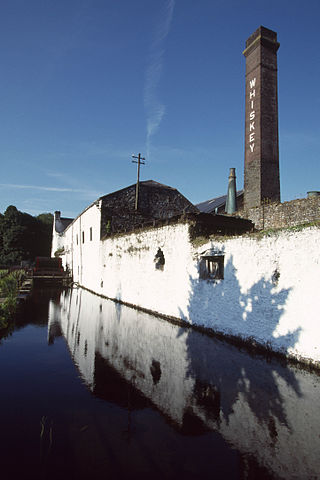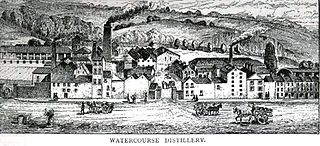
Irish whiskey is whiskey made on the island of Ireland. The word 'whiskey' comes from the Irish uisce beatha, meaning water of life. Irish whiskey was once the most popular spirit in the world, though a long period of decline from the late 19th century onwards greatly damaged the industry, so much so that although Ireland boasted at least 28 distilleries in the 1890s, by 1966 this number had fallen to just two, and by 1972 the remaining distilleries, Bushmills Distillery and Old Midleton Distillery, were owned by just one company, Irish Distillers.

A pot still is a type of distillation apparatus or still used to distill liquors such as whisky or brandy. In modern (post-1850s) practice, they are not used to produce rectified spirit, because they do not separate congeners from ethanol as effectively as other distillation methods. Pot stills operate on a batch distillation basis. Traditionally constructed from copper, pot stills are made in a range of shapes and sizes depending on the quantity and style of spirit desired.

Bladnoch distillery is a Lowland single malt Scotch whisky distillery located at Bladnoch, near Wigtown, Dumfries and Galloway in south west Scotland.

Kilbeggan Distillery is an Irish whiskey distillery situated on the River Brosna in Kilbeggan, County Westmeath, Ireland established in 1757 and owned by Suntory Global Spirits, a subsidiary of Suntory Holdings of Osaka, Japan.

Powers is a brand of Irish whiskey produced by the Irish Distillers subsidiary of Pernod Ricard. Historically a single pot still whiskey, the flagship Powers Gold Label brand was the first Irish whiskey ever to be bottled. Powers Gold Label was the best-selling whiskey in Ireland.

Benrinnes distillery is a malt whisky distillery in Aberlour producing an eponymous whisky. It was founded in 1826, and is still active. The distillery employed a unique partial triple distillation process until 2007.

The Old Midleton Distillery, also known as the Jameson Experience, Midleton, is an former Irish whiskey distillery that was turned into a museum and visitor centre located in Midleton, County Cork, Ireland. Set over 15 acres, since opening as a visitor's centre in 1992, the old distillery has received approximately 100,000 guests per year, receiving 125,000 in 2015.

Allman's Bandon Distillery was an Irish whiskey distillery which was established in 1826 in Bandon, County Cork, Ireland. The distillery closed in 1929 following financial difficulties. However, agents for the company trading under the name Allman, Dowden & Co., may have continued to sell off the existing stock which had built up in bonded warehouses, in both cask and bottled form, until 1939.

The Limavady Distillery was an Irish whiskey distillery distillery founded in 1750 in the borough of Limavady, County Londonderry, Ireland, close to Binevenagh mountain. All of the whiskey bottled under the Limavady whiskey brand was produced at the Limavady Distillery and used water drawn from the River Roe.

The Thomas Street Distillery was an Irish whiskey distillery located in Dublin, Ireland. At its peak, it was Dublin's largest and most productive distillery and with an output of over 2 million gallons per annum, twice that of John Jameson's acclaimed nearby Bow Street distillery.

The Marrowbone Lane Distillery was an Irish whiskey distillery located on Marrowbone Lane, in Dublin, Ireland. One of the "big four" historical Dublin whiskey firms, it was run by William Jameson, a member of the Jameson whiskey dynasty. However, the whiskey now known as Jameson Irish Whiskey was not produced at this distillery, but at the separate enterprise run by John Jameson at the nearby Bow Street Distillery. The distillery closed in 1923 following financial difficulties.

The North Mall Distillery was an Irish whiskey distillery located in Cork City, Ireland. In its day one of the most famous distilleries in Ireland, the distillery was destroyed by a fire in 1920. Distilling operations never resumed at the North Mall after the fire, and it was later converted into a bottling and storage facility which was used by Irish Distillers until 2007, at which point operations were transferred to Irish Distillers' other bottling facilities in Dublin. In the mid-2000s, much of the site was jointly acquired by University College Cork and Mercy University Hospital, and has since been redeveloped.

The Dundalk Distillery was an Irish whiskey distillery that operated in Dundalk, County Louth, Ireland between 1708 and 1926. It is thought to have been one of the old registered distilleries in Ireland. Two of the distillery buildings, the grain store and maltings, still exist and now house the County Museum and Dundalk Library.

Daly's Distillery was an Irish whiskey distillery which operated in Cork City, Ireland from around 1820 to 1869. In 1867, the distillery was purchased by the Cork Distilleries Company (CDC), in an amalgamation of five cork distilleries. Two years later, in 1869, as the smallest CDC distillery, Daly's Distillery ceased operations. In the years that followed its closure, some of the buildings became part of Shaw's Flour Mill, and Murphy's Brewery, with others continuing to be used as warehouses by Cork Distilleries Company for several years.
The Green Distillery was an Irish whiskey distillery which was established in Cork City, Ireland in 1796. In 1867, the distillery was purchased by the Cork Distilleries Company (CDC), in an amalgamation of five Cork distilleries. Production of whiskey at the distillery likely ceased soon afters its acquisition by the CDC. However, the distillery is known to have remained in use a bonded store by the Cork Distilleries Company for several years thereafter. In the mid-twentieth century, the distillery resumed operations as a gin distillery for a period of time, however, it has since been almost completely demolished.

The Watercourse Distillery was an Irish whiskey distillery which was established in Cork City, Ireland in 1795.
The Old Tullamore Distillery was an Irish whiskey distillery which was established in Tullamore, County Offaly, Ireland, in 1829. The original home of Tullamore Dew Irish whiskey, the distillery closed in 1954, having endured financial difficulties for many years, like many Irish whiskey distilleries of the early 20th century.

The Dublin Whiskey Distillery Company Jones Road Distillery, also known as the D.W.D. Distillery, Jones Road, or just Jones Road Distillery, was one of the six great Irish whiskey distilleries of Dublin city visited and documented by Alfred Barnard in his seminal 1887 publication "The Whisky Distilleries of the United Kingdom". It was located on the north side of the city on the banks of the River Tolka, approximately a mile north of the city centre. The distillery was built by the Dublin Whiskey Distillery Company Ltd and the Irish whiskey produced sold around the world under the brand name D.W.D.

Nun's Island Distillery was an Irish whiskey distillery which operated in Galway, Ireland, from at least 1815, and possibly as early as the late 1700s, until circa 1908.
Marlfield Distillery was an Irish whiskey distillery which operated in the village of Marlfield, just outside of Clonmel, Ireland between approximately 1817 and 1856.


















